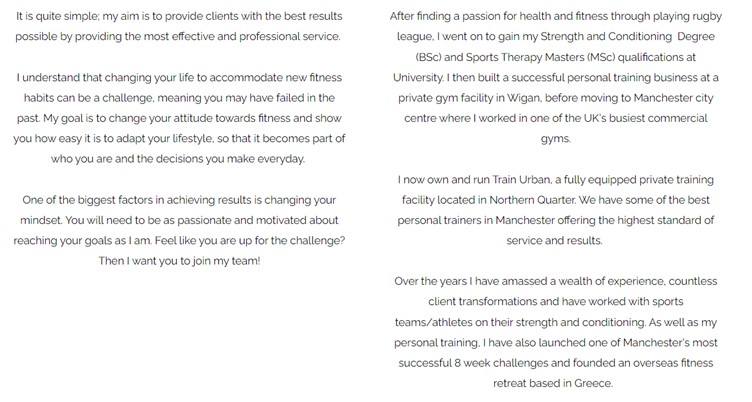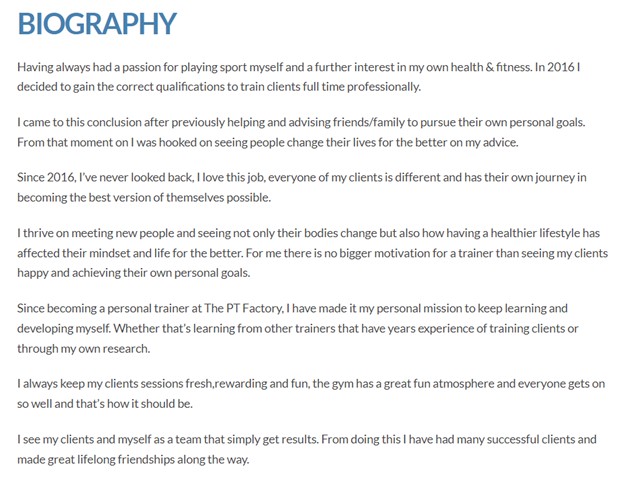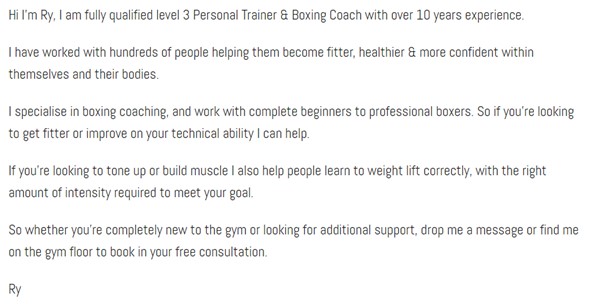How to write a personal trainer bio

Whether
you’re a personal trainer that’s just starting out or you’ve been in and around
the game for a long time, you’ll know all too well how important your marketing
is.
Knowing how
to market yourself as a personal trainer is one of the most effective ways of
securing new clients and keeping them. And having a good personal trainer bio
is a big part of this.
Your bio (biography) explains who you are and what you do.
What is a personal trainer bio?
Think of a
personal trainer bio like any other form of bio. Chances are you already have one
for your Twitter or Instagram account—what
does it say?
Your personal trainer bio is your chance to sell yourself, your experience, what you do, your expertise, and how you can help others.
Knowing how to write a personal trainer bio can be difficult, especially when first starting out. But a good bio should be relatively short, concise, and easy to read, but most importantly—persuade people to invest their time, money and trust in you.
How to write a personal trainer bio: 5 tips and tricks

Like most
marketing tactics, there’s no one-size-fits-all approach to writing a personal
trainer bio. Nobody knows what you can offer better than you do, so this is
your chance to flaunt it.
However, there are several things you can do to make your bio stand out from the crowd.
1. Write in the first person
First
thing’s first, writing your personal trainer bio in the first person is by no
means essential. In fact, you’ll find many trainers don’t bother.
Some argue
this writing style is a little egotistic—but writing in the first person makes your
bio a much more personal affair if done properly. Using pronouns such as I, we and us not onlyputs you in control but demonstrates
your personal attachment to the cause and makes the reader feel included and
part of the experience you’re selling.
Writing in the first person allows you to build a direct rapport with readers, adds credibility and authenticity to your words, and helps readers visualise the success you can achieve together.
2. Focus on your clients and what they want
This point
may seem to undermine the one above, but in reality—it shouldn’t.
Although
writing in the first person, you must be careful not to make your personal
trainer bio all about you. Yes, clients want to know that you’re qualified and can
provide what they’re looking for, but that should never be the sole focus.
Your bio should demonstrate that you understand your client’s needs and will put them at the heart of your training programmes. Whether your client wants to lose weight, bulk up, or just get fitter—show them that you understand and can help them do so.
Nobody wants to work with a self-obsessed PT. Trust us!
3. Include relevant personal touches
Indeed, people
often feel more inspired by others that have been through similar experiences.
Think back
to before you became a personal trainer and what first inspired you to become
one. Perhaps you were unhappy with your physique and wanted to change, or maybe
you’ve overcome certain obstacles or a traumatic experience to get to where you
are today.
Your
clients and potential clients will likely be going through the same. So,
include those relevant personal touches in your bio, and your clients will
relate to you.
Remember—friends first, clients second.
4. Don’t waffle and avoid jargon
A good personal
trainer bio should be short, sharp, and understandable.
Don’t use overcomplicated industry jargon that ordinary people won’t understand. Speak in everyday terms and get to the point.
5. Sound approachable
Once you’ve
written the first draft of your bio (yes, there’s nothing wrong with having a
few attempts before settling on the final version), get a friend or family
member to read it and give you honest feedback. Would they work with you based
on what you’ve written if they didn’t know you?
Read it
back yourself, too. Would you work with you?
If the answer’s no, you’ve got work to do still. Research suggests many people often find gyms and exercise environments scary and intimidating, so your bio should allay those fears and make readers think more positively about starting their fitness journey.
Personal trainer bio examples
Though, of
course, your personal trainer bio should be unique to you, there’s nothing
wrong with checking out a few existing online bios for creative inspiration. In
fact, we’d encourage it.
The
personal training and fitness industry strives to be an inclusive, welcoming
one—and as competitive as it gets at times, you’ll still find many personal
trainers out there willing to give others a helping hand.
We’ve picked a few personal trainer bios that stand out to us. See what you think.

We like
this bio because it mentions helping clients in the first line. Straight away,
this tells us that this PT has their priorities in order.
This trainer also shows that they understand the challenges people face when striving for personal change but will do their best to help and motivate. It’s a yes from us.

This bio
contains those all-important personal touches we mentioned earlier, and it’s pretty
clear that this PT loves what they do. You should never underestimate the power
of enthusiasm when trying to motivate others.
After all—if you aren’t passionate yourself, how can you expect others to be?

Again, this PT gets straight to the point with how they aim to help their clients. The first paragraph alone tells readers everything they can expect from working with this PT, and demonstrates their knowledge of good nutrition, too, as well as exercise.

Remember what we said earlier about being approachable? This bio is a fantastic example of that. By encouraging people to find them on the gym floor for a chat, this PT comes across as friendly and paints a welcoming picture of themselves and their gym.
Having a well-written
personal trainer bio is one thing, but you may also want to consider protecting
yourself and your clients with insurance if you’re serious about a career in
personal training. Not only is having insurance often a requirement to work in
certain gyms, but you may also find some clients are unwilling to work with you
unless you have it.
With Insure4Sport, specialist personal trainer insurance is designed to cover you if your equipment is lost, damaged, stolen, or if a client makes a claim against you.
Learn more about specialist personal trainer insurance with Insure4Sport and get an online quote today.
Related
How to design personal training packages (step-by-step)
6 essential legal forms for your personal training business
How to use PT testimonials to boost your business






